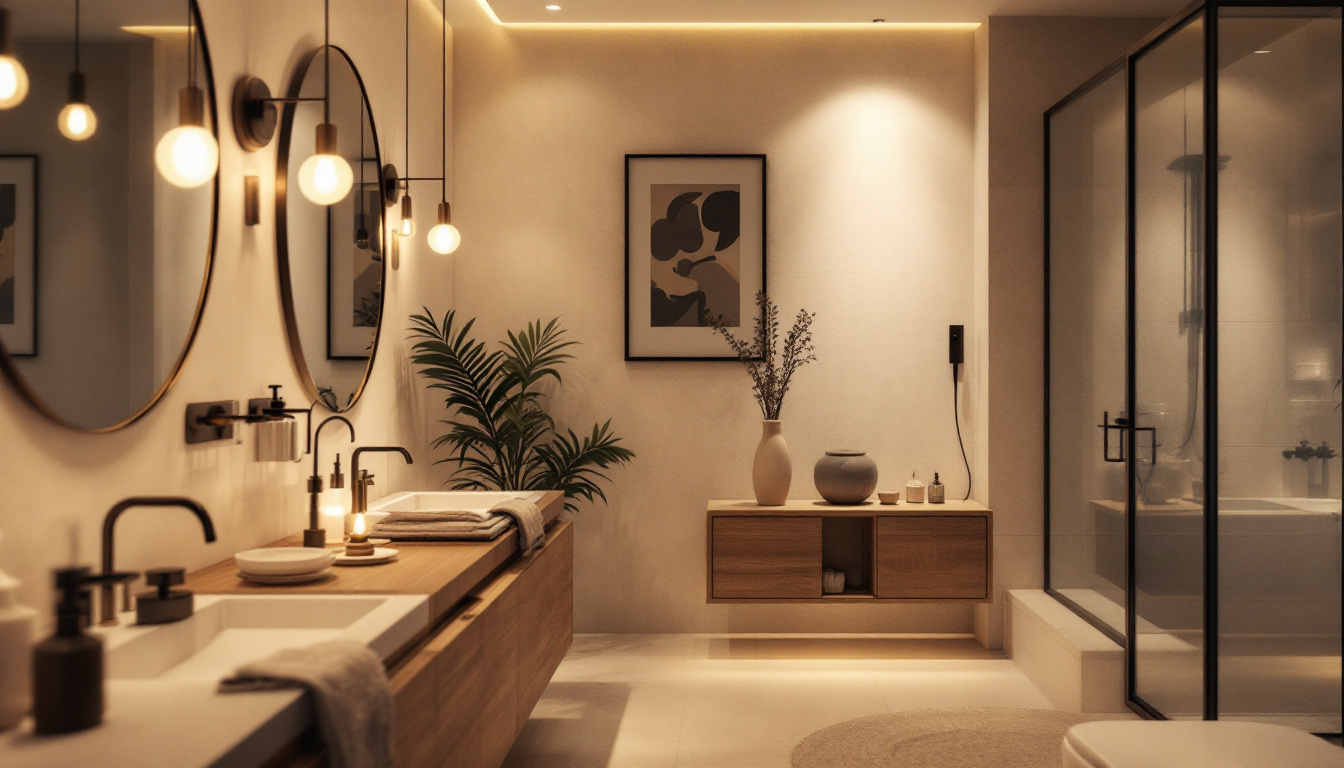

LED flat ceiling lights have become a popular choice for dining rooms due to their sleek design and energy efficiency. These lights not only provide ample illumination but also enhance the aesthetic appeal of the space. Understanding their features and benefits is crucial for lighting contractors aiming to optimize their use in residential settings.
Unlike traditional lighting options, LED flat ceiling lights are designed to distribute light evenly across the room. This uniformity minimizes shadows and creates a welcoming atmosphere, making them ideal for dining areas where ambiance is essential. Additionally, their low-profile design allows for installation in spaces with limited ceiling height, ensuring that they fit seamlessly into various architectural styles.
One of the standout features of LED technology is its energy efficiency. Compared to incandescent or fluorescent lights, LED flat ceiling lights consume significantly less power while providing the same, if not better, illumination. This efficiency translates into lower energy bills for homeowners, making it an attractive selling point for lighting contractors.
Furthermore, LEDs have a longer lifespan, often lasting up to 25,000 hours or more. This longevity reduces the frequency of replacements, which not only saves money but also minimizes waste, aligning with sustainable practices that are increasingly important to consumers. In addition, many LED flat ceiling lights are now designed with dimming capabilities, allowing homeowners to adjust the brightness according to their needs. This feature not only enhances energy savings but also adds to the versatility of the lighting, making it suitable for various occasions—from intimate family dinners to lively gatherings with friends.
The design versatility of LED flat ceiling lights is another factor to consider. Available in various shapes, sizes, and finishes, these lights can complement any dining room decor, from modern minimalist to classic elegance. Contractors can recommend options that align with the homeowner’s style preferences, ensuring that the lighting enhances the overall design of the space.
Moreover, the ability to choose between different color temperatures allows for further customization. Warmer tones can create a cozy atmosphere, while cooler tones may be more suitable for contemporary settings. This flexibility enables contractors to tailor their recommendations to meet the specific needs of each client. Beyond color temperature, many LED flat ceiling lights also feature adjustable color rendering indexes (CRI), which can significantly impact how colors appear in the room. A higher CRI can make food look more appetizing and vibrant, enhancing the dining experience. Additionally, some models come equipped with smart technology, allowing homeowners to control their lighting through mobile apps or voice commands, thus integrating seamlessly into the modern smart home ecosystem.
To optimize the efficiency of LED flat ceiling lights in dining rooms, several strategies can be employed. These strategies not only enhance the lighting quality but also contribute to energy savings and improved functionality.
Implementing a layered lighting approach is essential for creating a well-lit dining room. This involves combining ambient, task, and accent lighting to achieve a balanced and inviting atmosphere. LED flat ceiling lights can serve as the primary ambient light source, providing general illumination throughout the room.
In addition to the ceiling lights, incorporating task lighting, such as pendant lights over the dining table or wall sconces, can enhance functionality. Accent lighting can be used to highlight artwork or architectural features, adding depth and interest to the space. By strategically layering these different types of lighting, contractors can create a more dynamic and versatile environment. For instance, dimmable LED fixtures can allow for adjustments in brightness, enabling homeowners to set the mood for various occasions, whether it’s a casual family dinner or an elegant dinner party.
The placement and spacing of LED flat ceiling lights are critical factors that influence their effectiveness. For optimal illumination, it is recommended to space the lights evenly across the ceiling. A common guideline is to position lights approximately two to three feet apart, depending on the size of the room and the wattage of the fixtures.
Contractors should also consider the height of the ceiling when determining placement. In rooms with higher ceilings, additional fixtures or adjustable lights may be necessary to ensure adequate illumination. Conversely, in lower-ceilinged spaces, a single row of fixtures may suffice. Proper placement not only maximizes lighting efficiency but also enhances the overall aesthetic appeal of the dining room. Additionally, it is beneficial to consider the color temperature of the LED lights; warmer tones can create a cozy and inviting atmosphere, while cooler tones may be more suitable for modern, minimalist designs. Furthermore, utilizing smart lighting technology can provide homeowners with the ability to control their lighting remotely, allowing for customized settings that suit their lifestyle and preferences.
Selecting the appropriate LED flat ceiling light involves considering various factors, including brightness, color temperature, and design. Each of these elements plays a crucial role in achieving optimal lighting efficiency and meeting the specific needs of the dining room.
Brightness is measured in lumens, and understanding the required lumens for a dining room is essential for contractors. A general guideline suggests aiming for around 100-200 lumens per square meter. This level of brightness ensures that the dining area is well-lit without being overly harsh.
When recommending fixtures, contractors should also consider the dimming capabilities of the lights. Dimmable LED flat ceiling lights allow homeowners to adjust the brightness according to the occasion, creating a versatile lighting solution that can adapt to different moods and activities. For instance, a bright setting may be ideal for family gatherings or dinner parties, while a softer glow can enhance intimate dinners or relaxed evenings at home.
The color temperature of LED lights is measured in Kelvins (K), and it significantly impacts the ambiance of the dining room. Warmer tones (2700K to 3000K) create a cozy and inviting atmosphere, ideal for family dinners and gatherings. On the other hand, cooler tones (3500K to 4100K) can promote a more modern and energetic feel, suitable for contemporary dining spaces.
Contractors should engage in discussions with homeowners about their preferences and the desired atmosphere they wish to create. This dialogue can guide the selection process and ensure that the chosen color temperature aligns with the overall design vision. Additionally, it’s worth considering how the color temperature interacts with other elements in the room, such as wall colors and furniture finishes. For instance, warmer light can enhance wooden tones and earthy colors, while cooler light can complement sleek, modern decor.
Another factor to consider is the placement of the LED flat ceiling light. The positioning can dramatically influence how light is distributed throughout the dining area. For example, a centrally located fixture can provide even illumination, while multiple fixtures can create layers of light, adding depth and interest to the space. Homeowners might also explore the option of integrating accent lighting or decorative elements that can work in harmony with the ceiling light, further enhancing the overall aesthetic of the dining room.
Proper installation of LED flat ceiling lights is crucial for maximizing efficiency and performance. Following best practices not only enhances the functionality of the lights but also ensures safety and longevity.
Before installation, it is essential to assess the existing electrical system. Ensuring that the circuit can handle the wattage of the new LED fixtures is vital to prevent potential overloads. Additionally, using compatible dimmer switches can enhance the functionality of the lighting system.
Contractors should also follow local electrical codes and regulations during installation. This adherence not only ensures safety but also provides peace of mind for homeowners, knowing that their lighting system is installed correctly.
When installing LED flat ceiling lights, alignment and aesthetics should be prioritized. Ensuring that fixtures are level and evenly spaced contributes to a polished and professional look. This attention to detail enhances the overall appeal of the dining room and reflects positively on the contractor’s work.
Moreover, considering the visual impact of the fixtures is essential. Selecting designs that complement the dining room’s decor can elevate the space and create a cohesive look. Contractors should take the time to discuss design options with homeowners to ensure satisfaction with the final result.
Maintaining LED flat ceiling lights is relatively straightforward, but it is crucial for ensuring their longevity and performance. Educating homeowners about proper care can enhance their satisfaction and prolong the life of the fixtures.
Dust and dirt can accumulate on light fixtures, reducing their brightness and efficiency. Regular cleaning with a soft cloth or microfiber duster can help maintain optimal performance. Homeowners should be advised to turn off the lights and allow them to cool before cleaning to prevent any accidents.
Additionally, checking for any signs of wear or damage during cleaning can help identify potential issues before they become significant problems. Encouraging homeowners to be proactive in their maintenance will contribute to the longevity of their lighting system.
As technology continues to evolve, homeowners may benefit from upgrading their LED flat ceiling lights to newer models that offer enhanced features. Smart LED lights, for example, allow for remote control and automation, providing added convenience and energy savings.
Contractors should stay informed about the latest advancements in LED technology and share this knowledge with clients. By offering upgrade options, contractors can enhance their service and provide homeowners with the best possible lighting solutions.
Optimizing LED flat ceiling lights in dining rooms is a multifaceted process that involves understanding the technology, maximizing efficiency, and ensuring proper installation and maintenance. By employing a layered lighting approach, selecting the right fixtures, and adhering to best practices, lighting contractors can create well-lit, inviting dining spaces that meet the needs of homeowners.
Ultimately, the goal is to enhance the dining experience through effective lighting solutions. By staying informed about the latest trends and technologies in LED lighting, contractors can position themselves as trusted experts in the field, providing valuable insights and recommendations to their clients.
Ready to elevate your lighting game? At LumenWholesale, we provide contractors with the finest spec-grade LED flat ceiling lights and more, ensuring every dining room shines with efficiency and style. Our commitment to quality and affordability means you can access the best lighting products at wholesale prices, with the convenience of free shipping on bulk orders. Don’t let middleman markups dim your project’s potential. Choose LumenWholesale for lighting that meets the highest industry standards. Discover wholesale lighting at the best value today and brighten your clients’ dining experiences with confidence.

Discover essential insights into drop ceiling lights with our comprehensive guide tailored for lighting contractors.

Discover why opting for local distributors might not be the best choice when purchasing commercial sign lights in bulk.

Discover essential insights into bathroom lighting fixtures that every lighting contractor should know.

Discover innovative cost-saving strategies for lighting contractors with GE Lighting.
Get notified when NEW deals are released.
Optimize your budget with wholesale discounts.
Only top-quality, specification-grade lighting products.
No additional costs at checkout - what you see is what you pay.
We understand the unique needs of contractors.